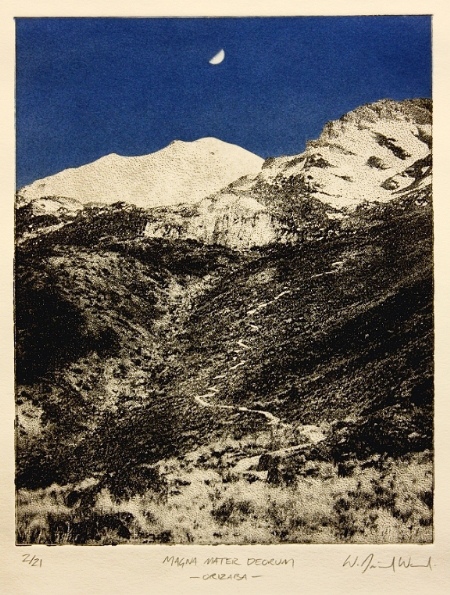| Currently Gallery Original Prints Books Bio Contact Home |
The timeless quality of a hand-made print, in this world of fleeting, virtual images, speaks of something more enduring. Fads and fashions come and go in the world of art, but generally say very little about the larger world. Etchings, however, have stood the test of time – indeed, the word itself is synonymous with this idea – and these quiet, understated representations have documented the ages. The embossed intaglio impression stands in stark contrast to the art of our times, and amidst the clamour, I find these classical images are a refreshing departure. |
 |
 |
 |
Available images - two more will be posted in August |
|
 |
Etching 9" x 6" (Image size) watercolour paper, hand-coloured |
Magna Mater Deorum "Having come to regard this mountain as the seat of my own personal Muse, |
Standing at the foot of a winding trail that leads up to the Jamapa Glacier, on the north face of Pico de Orizaba, the sense of foreboding was almost overwhelming. The last time my friends had climbed here, vicious, icy winds foiled their summit bid. On an earlier ascent, one of their team members succumbed to altitude sickness and died on the slopes. It was with great trepidation that we started upward at 1:30 a.m., past the crosses and memorials of fallen climbers. We kept our headlamps to the earth and watched our footing on the loose rocks, but the bitter cold soon began to bite at our faces. Above us soared "The Sarcophagus," a jagged prominence around which we would have to traverse before moving up onto the glacier. The moon quickly dropped from view and in the rarefied atmosphere the heavens beckoned. The stars were brighter than I had ever seen them and, just before dawn as we ascended to near 15,000 feet, it was as if we stood at the very edge of space. Citlaltépetl – "Star Mountain" – as it is known in the Nahuatl language, was a fitting name for this peak. Those who chose to rename her must never have spent a night at this elevation. |
The idea of "original prints" has intriged me for a very long time. The tactile quality of these largely monochrome impressions (on watercolour paper) lends itself to the kind image that capture my imagination. One would think that images rendered in black and white alone would be cold and stark, yet, to my eyes at least, they have a dreamy, inviting quality. Though I've always worked in colour, this medium allows me to focus on two other aspects which, in my own opinion, are far more important: composition and detail. Both of these are often diminished by the presence of colour, because of the emotional response it evokes; thus etching, like works in graphite, appeals to the sophisticated viewer. |
© W. David Ward All rights reserved |

